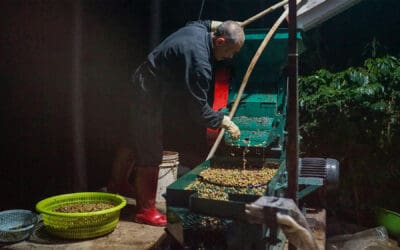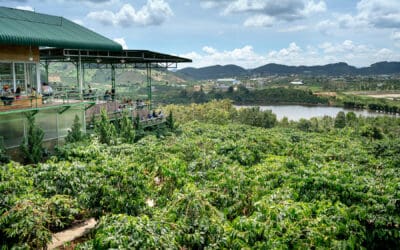Imagine a world-class espresso shot—each molecule a carefully composed note, every sip a potential revelation.
But what if I told you that the magic of this experience begins long before the first drop hits your cup, in the intricate coffee processing methods?
The Unseen Conductor
Miguel Meza, a renowned coffee producer and roaster, once showed me something that changed how I understand espresso forever. Standing in a small processing facility in Panama, he held two seemingly identical green coffee beans and said, “Watch closely.”
What followed was a masterclass in how processing methods are not just technical steps, but narratives, fundamentally transforming coffee’s potential.
Processing: The Flavour’s First Draft
There are three primary processing methods, each ginving a different spin to the final product:
1. Washed Processing: The Minimalist Approach
- Character: Crisp, clean, transparent
- Technique: Removes all fruit before drying
- Espresso Profile: Bright, linear flavor progression
- Best For: Single-origin shots seeking pure articulation
2. Natural Processing: The Bold Narrator
- Character: Intense, fruity, complex
- Technique: Dries coffee cherries whole
- Espresso Profile: Thick body, wine-like complexity
- Best For: Adventurous blends, experimental shots
3. Honey Processing: The Nuanced Storyteller
- Character: Balanced, subtle sweetness
- Technique: Partial fruit removal before drying
- Espresso Profile: Smooth transition between brightness and depth
- Best For: Sophisticated espresso blends
The Science Behind the Story
Research from the Journal of Agricultural and Food Chemistry confirms what baristas intuitively understand: processing methods fundamentally alter coffee’s chemical composition. A 2022 study revealed that natural processed coffees contain up to 30% more fruit-derived compounds compared to washed coffees, directly translating to more intense flavour profiles.
Practical Implications for Home Baristas
Espresso Experiment: A Personal Challenge
1.
Buy Three Bags: One washed, one natural, one honey processed
2.
Roast Level: Maintain consistency (medium-light)
3.
Extraction Parameters:
- Temperature: 93-96°C
- Pressure: 9 bars
- Grind: Fine, consistent
4.
Tasting Protocol:
- Pull shots
- Note flavor progression
- Compare mouthfeel
- Document your findings
The Unexpected Twist
Here’s where it gets interesting. The same coffee, processed differently, can produce radically different espresso experiences. A Guatemalan Huehuetenango natural processed coffee might deliver wild blueberry and dark chocolate notes, while its washed counterpart could present clean, bergamot-like brightness.
Beyond Technique: A Cultural Conversation
Processing isn’t just a technical procedure—it’s a dialogue between producer, environment, and consumer. Each method represents a cultural approach to transforming a agricultural product into a sensory experience.
Call to Action: Build Your Flavour Map
- Share Your Experiments: Use #EspressoProcessing when posting to social media
- Join Online Communities: Coffee forums, Reddit’s r/espresso is a good one
- Attend Local Tastings: Many coffee shops offer processing-focused events. Sign up and attend.
The Larger Narrative
Understanding processing methods isn’t about technical superiority—it’s about appreciating coffee’s incredible complexity. Each method is distinctive, and as baristas and enthusiasts, we’re both receptive to the subtleties.
Disclaimer:
Flavour experiences are subjective. Your palate is the ultimate authority. Be sure to comment with your experiences. Share, friend, follow and subscribe to The Coffee Authority Weekly. We are all made richer in the sharing.


0 Comments